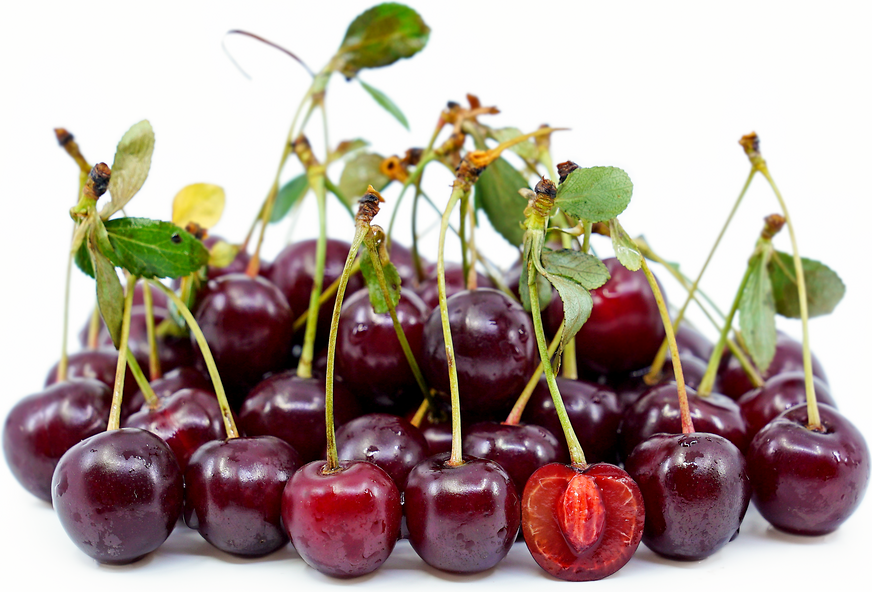


Schattenmorelle Cherries
Estimated Inventory, lb : 0
Description/Taste
Schattenmorelle cherries are smaller fruits, averaging 1 to 2 centimeters in diameter, and have a round, oval, to cordate shape attached to long and slender green stems. The stems average 3 to 4 centimeters in length and are often sold with small green leaves still connected. The fruit’s skin is thin, glossy, taut, delicate, and smooth, ranging in color from bright red, crimson to dark red-black, depending on maturity. Underneath the surface, the dark red pulp is soft, aqueous, and tender, encasing a freestone pit easily separated from the flesh. Schattenmorelle cherries contain high acidity and some sugar, developing an initially sour, tart, and tangy flavor followed by a subtly sweet, fruity aftertaste. In addition to the fruits, Schattenmorelle cherry trees also bear showy white flowers in the spring, typically grouped in clusters of 2 to 4 blooms.
Seasons/Availability
Schattenmorelle cherries are available in the summer.
Current Facts
Schattenmorelle cherries, botanically classified as Prunus cerasus, are late-season tart fruits belonging to the Rosaceae family. The dark red cherries grow on smaller trees that reach up to 8 meters in height and are a European variety highly favored for its sour, fruity, and subtly sweet taste. Schattenmorelle cherries are also known as Griotte de Nord, Chatel Morel, and English Morello cherries and are one of the most cultivated sour cherries in Europe, a part of the morello group. The trees are self-pollinizing, valued by growers for their productive nature and reliable cropping, and the fruits are only available for a short season, increasing their demand. Schattenmorelle cherries are not commonly consumed fresh and are utilized by chefs for their astringency and acidity in sauces, baked goods, and preserves.
Nutritional Value
Schattenmorelle cherries are an excellent source of anthocyanins, colored pigments in the flesh that contain antioxidant-like properties to protect the cells against free radical damage. The cherries also contain vitamin A to maintain healthy organ functioning, vitamin C to strengthen the immune system and reduce inflammation, and potassium to balance fluid levels within the body.
Applications
Schattenmorelle cherries have a tart flavor generally considered too sour to consume straight, out of hand, but the tangy fruits are well suited for preparations with added sweeteners. The cherries can be cooked with sugar and water to make a syrup, and the mixture can be drizzled over ice cream, waffles, pancakes, yogurt, and pudding. The syrup can also be incorporated into cocktails and non-alcoholic drinks such as Shirley temples. In addition to syrup, Schattenmorelle cherries are popularly simmered into sauces and reductions, often used to flavor barbeque sauces, balsamic glazes, or salad dressings. The cherries can also be cooked into jams and chutney and slathered over roasted meats, bread, or vegetables. Schattenmorelle cherries retain their bright red coloring throughout the cooking process and are widely favored for pies, cakes, cobblers, crisps, tarts, and muffins. They can also be pickled as a sweet and tangy condiment. Schattenmorelle cherries pair well with meats such as lamb, pork, poultry, and duck, vanilla, chocolate, cinnamon, fennel, dark leafy greens, blackberries, blueberries, and rosemary. Whole, unwashed Schattenmorelle cherries are highly perishable and will only keep 3 to 7 days when stored with the stems intact in the refrigerator. The cherries can also be pitted and frozen for extended use.
Ethnic/Cultural Info
Sour cherries are famously used in Black Forest cake, also known as Black Forest gateau, a decadent dessert comprised of chocolate, cherries, whipped cream, and frosting. The recipe was first officially recorded in Germany in the 1930s, but some historians believe the cake may date back as early as the 1500s, around the time when chocolate was introduced into Europe from the New World. There are several legends as to how the cake acquired its name. The first theory points to the cake being named after the densely wooded Black Forest region in southwestern Germany. The region was known for its sour cherry production, and historically, one of the most popular products made within the Black Forest region was kirschwasser, a brandy distilled from sour cherries. Kirschwasser is also known as kirsch and is a featured ingredient in some Black Forest cake recipes, contributing moisture and flavor. Another theory parallels the colors in the cake as matching the colors in traditional outfits worn by women in the Black Forest region. Regardless of the origins, Black Forest cake utilizes the tangy, fruity nature of sour cherries to balance the rich flavors of the whipped cream and chocolate. The cake is a favorite dessert throughout Europe, especially in Switzerland, Austria, Italy, and Germany, and is also made in the United States.
Geography/History
Sour cherries are believed by experts to be native to Eastern Europe and Southwestern Asia. The fruit trees have been found growing in the Caucasus Mountains between the Black Sea and Caspian Sea and were created through a natural cross between Prunus avium and Prunus fruticose cherries. Sour cherries were later selected for cultivation in the Early Ages and were spread throughout Europe. The exact history of Schattenmorelle cherries is unknown, but experts believe the variety may have been discovered in Germany or Holland sometime before the 16th century and introduced into France and England. Over time, the sour fruits were planted worldwide for cultivation and used in a variety of cooked preparations. Today Schattenmorelle cherries are found through select farms and specialty distributors in Europe, Asia, Australia, North America, and South America. The Schattenmorelle cherries featured in the photograph above were sourced from Andy’s Orchard in Morgan Hill, California.
Recipe Ideas
Recipes that include Schattenmorelle Cherries. One




